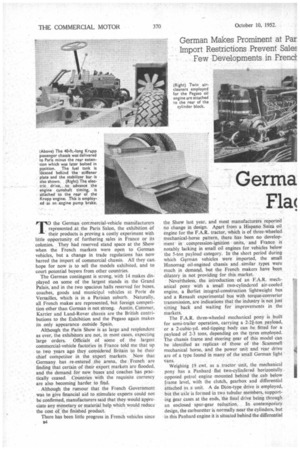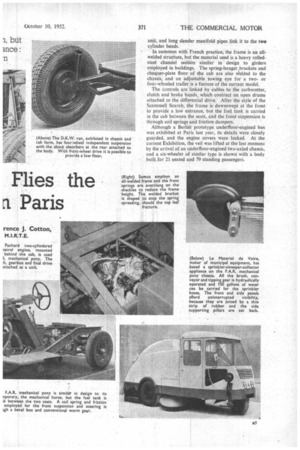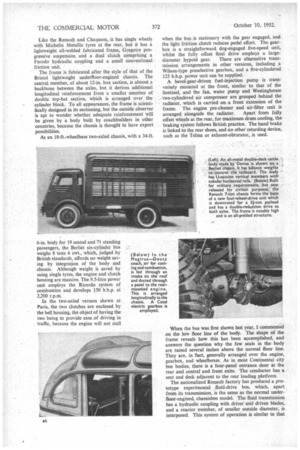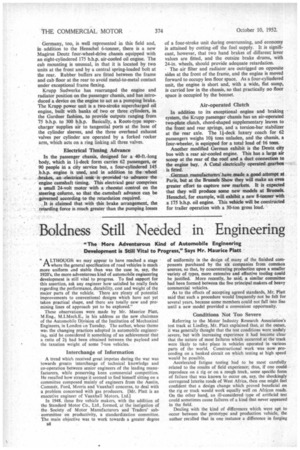T . the German commercial-vehicle manufacturers represented at the Paris Salon,
Page 38

Page 39

Page 40

Page 41

Page 42

If you've noticed an error in this article please click here to report it so we can fix it.
the exhibition of their products is proving a costly experiment with little opportunity of furthering sales in France or its colonies. They had reserved stand space at the Show when the French markets were open to German vehicles, but a change in trade regulations has now barred the import of commercial chassis. All they can. hope for now is to sell the models exhibited, and to court potential buyers from other countries.
The German contingent is strong, with 14 makes displayed on some of the largest stands in the Grand Palais, and in the two spacious halls reserved for buses, coaches, goods and municipal vehicles at Porte de Versailles, which is in a Parisian suburb. Naturally, all French makes are represented, but foreign competition other than German is not strong. Austin, Cornmer, Karrier and Land-Rover chassis are the British contributions to the Exhibition and the Pegaso again makes its only appearance outside Spain.
Although the Paris Show is as large and resplendent as ever, the exhibitors are not, in most cases, expecting large orders. Officials of some of the largest commercial-vehicle factories in France told me that up to two years ago they considered. Britain to be their chief competitor in the export markets. Now that Germany has re-entered the arena, the French are finding that certain of their export markets are flooded, and the demand for new buses and coaches has practically ceased. Countries with the requisite currency are also becoming harder to find.
Although the rumour that the French Government was to give financial aid to stimulate exports could not be confirmed, manufacturers said that they would appreciate any monetary or material help which would reduce the cost of the finished product. .
There has been little progress in French vehicles since
the Show last year, and most manufacturers reported no change in design. Apart from a Hispano Suiza oil engine for the F.A.R. tractor, which is of three-wheeled.
mechanical-horse pattern, there has been no development in compression-ignition units, and France is notably lacking in small oil engines for vehicles below the 5-ton payload category. In the short period during which German vehicles were imported, the small Hanomag oil-engined chassis and similar types were much in demand, but the French makers have been dilatory in not providing for this:market.. • Neveitheless, the introduction of an F.A.R. mechanical pony with a small two-cylindered air-cooled,
engine, a Berliet integral-construction 'lightweight bus and a Renault experimental bus with torque-converter -transmission, are indications that the industry is, not just sitting back and waiting for improvements in the markets.
The F.A.R. three-wheeled mechanical pony is built for semi-trailer operation, carrying a 2-2f-ton payload, or a 2-cubic-yd. end-tipping body can be fitted for a payload of 2-3 tons, depending on the tyres employed. The chassis frame and steering gear of this model can be identified as replicas of those of the Scammell mechanical horse, and the power unit and rear drive are of a type found in many of the small German light vans.
Weighing 19 cwt. as a tractor unit, the mechanical pony has a Panhard flat two-cylindered horizontally opposed petrol engine mounted behind the cab below
frame level, with the clutch, gearbox and differential attached as a unit. A de Dion-type drive is employed,
but the axle is formed in two tubular members, supporting gear cases at the ends, the final drive being through an enclosed spur-gear reduction.' In contemporary design, the carburetter is normally near the cylinders, but in this Panhard engine it is situated behind the differential unit, and long slender manifold pipes link it to the two cylinder heads.
In common with French practice, the frame is an allwelded structure, but the material used is a heavy rolledsteel channel seetiOn similar in design to girders employed in buildings. The spring-hanger bracketsand chequer-plate floor of the cab are also wYelded to the chassis, and an adjustable towing eye for a twoor four-wheeled trailer is a feature Of the current model.
The controls are linked by cables to the carburetter, clutch and brake bands, which contract on open drums attached to the differential drive. After the style of the Scammell Scarab, the frame is downswept at the front to provide a low entrance, but the fuel tank is carried in the cab between the seats, and the front suspension is through coil springs and friction dampers.
Although a Berliet prototype underfloor-engined bus was exhibited at Paris last year, its details were closely guarded, and the engine covers were locked. At the current Exhibition, the veil was lifted at the last moment by the arrival of an underfloor-engined two-axled chassis, and a six-wheeler of similar type is shown with a body built.for 21 seated and 79 standing passengers. Like the Renault and Chausson, it has single wheels with Michelin Metallic tyres at the rear, but it has a lightweight all-welded fabricated frame, Gregoire progressive suspension and a dual clutch comprising a Ferodo hydraulic coupling and a small conventional friction unit.
The frame is fabricated after the style of that of the Bristol lightweight underfloor-engined chassis. The central member, of about 12-in, box section, is almost a backbone between the axles, but it derives additional longitudinal reinforcement from a smaller member of double top-hat section, which is arranged over the cylinder block. To all appearances, the frame is scientifically designed in its sectioning, but the outside observer is apt to wonder whether adequate reinforcement will be given by a body built by coachbuilders in other countries, because the chassis is thought to have export possibilities.
As an 18-ft.-wheelbase two-axled chassis, with a 34-ft.
6-in. body for 19 seated and 71 standing passengers, the Berliet six-cylinder bus weighs 8 tons 6 cwt., which, judged by British standards, affords no weight saving by integration of the body and chassis. Although weight is saved by using single tyres, the engine and clutch housing are massive. The 9.5-litre power unit employs the Ricardo system of combustion and develops 150 b.h.p. at 2,200 r.p.m.
In the two-axled version shown at Paris, the two clutches are enclosed by the bell housing, the object of having the two being to provide ease .of driving in traffic, because the engine will not stall when the bus is stationary with the gear engaged, and the light friction clutch reduces pedal effort. The gearbox is a straightforward dog-engaged five-speed unit, whilst the fully offset final drive employs a large diameter hypoid gear. There are alternative transmission arrangements in other versions, including ,a Wilson-type preselective gearbox, and a five-cylindered 125 b.h.p power unit can be supplied.
A bevel-gear-driven fuel-injection pump is transversely mounted at the front, similar to that of the Sentinel, and the fan, water pump and Westinghouse two-cylindered air compressor are grouped behind the radiator, which is carried on a front extension of the frame. The engine pre-cleaner and air-filter unit is arranged alongside the radiator. Apart from fully offset wheels at the rear, for maximum drum cooling, the braking system follows British practice. The hand brake is linked to the rear shoes, and no other retarding device, such as the Telma or exhaust-obturator, is used.
When the bus was first shown last year, I commented on the low floor line of the body. The shape of the frame reveals how this has been accomplished, and answers the question why the few seats in the body are raised several inches above the normal floor line. They are, in fact, generally arranged over the engine, gearbox, and whe,elboxes. As in most Continental city bus bodies, there is a four-panel entrance door at the rear and central and front exits. The conductor has a seat and desk adjacent to the rear loading platform.
The nationalized Renault factory has produced a prototype experimental fluid-drive bus, which, apart from its transmission, is the same as the normal underfloor-engined, chassisless model. The fluid transmission has a hydraulic coupling with driver arid driven blades, and a reactor member, of smaller outside diameter, is interposed. This system of operation is similar to that of the Hobbs transmission, except that the main driven member is attached to the outer annulus of an epicyclie unit, and the reactor operates the pinion carrier.
At low engine speed the reactor, in effect, reduces the speed of the sun gear attached to the forward-reverse gearbox input shaft, and the overall ratio is altered in variation with the speed. A centrifugal clutch unit, attached to the gearbox shaft, has weights to operate hydraulic valves, which boost the hydraulic coupling to direct drive.
Unlike the Earls Court Commercial Motor Show, which is noted throughout the world for working sectioned exhibits, the Paris Show has none, except on the Commer stand. A working model of the Renault transmission might provide a valuable technical explanation. As it is, the complete unit is installed in the chassis, and there are no printed details of its working or internal arrangements. I was informed that during the manufacturer's tests, there had been no increase of fuel consumption, compared with the use of a conventional friction-clutch transmission. It is understood that this is a prototype unit, which has not yet been offered to any operator.
Most of the buses, coaches and heavy lorries built in France have the Telma or exhaust-obturator brake, but in an underfloor-engined model, the short transmission shaft does not provide space for the Telma unit. Renault has overcome this difficulty by extending the axle pinion shaft to the rear of the axle, where an additional propeller shaft is introduced to link the Telma unit, which is mounted at the extreme rear of the frame overhang.
Although not installed in a vehicle, a new type of fuel-injection pump, made by La Precision Mecanique, is shown fitted to a Panhard oil engine. This unit, it is
drive are offset.
understood, is being tried experimentally by French manufacturers, and, in place of the conventional camshaft and multi-element arrangement, employs a single piston and rotating distributor assembly.
Bernard, a concern which has formerly used an oil engine built under Gardner licence, is now fitting a new power unit which has a monobloc crankcase and cylinder block casting. This is a cleanly built unit, notably free from external fittings and equipped with a Lavalette injection pump.
French manufacturers have been building fourwheel-drive chassis for the government, and a spate of these is exhibited, in addition to the special vehicles shown by Herwaythom. Judged by their British counterparts, they are all heavily built, and considerable chassis pruning could be done to improve performance without affecting reliability.
Notable among the cross-country machines is the Renault, which, equipped with an amidship-mounted horizontal oil engine, surpasses all others in its frame height. It is based on the 7-ton chassis with doublereduction drive at both axles, but the frame and suspension are heavily reinforced, and the payload capacity is downrated to 3i tons. An unusual feature is that 11.00-20-in. twin tyres ate fitted at the rear. Other makes showing four-wheel-drive chassis include Panhard, with an all-welded rolled-steel channel-section frame, a Berliet built by Herwaythorn and a Ford petrol-engined chassis with Marmon-Herrington conversion. Germany, too, is well represented in this field and, in addition to the Henschel 6-tonner, there is a new Magirus Deutz four-wheel-drive chassis equipped with an eight-cylindered 175 b.h.p. air-cooled oil engine. The cab mounting is unusual, in that it is located by two units at the front and by a central spring-loaded bolt at the rear. Rubber buffers are fitted between the frame and cab floor at the rear to avoid metal-to-metal contact under exceptional frame flexing.
Krupp Sudwerke has rearranged the engine and radiator position on the passenger chassis, and has introduced a device on the engine to act as a pumping brake. The Krupp power unit is a two-stroke supercharged oil engine, built with banks of two or three cylinders, in the Gardner fashion, to provide outputs ranging from 75 b.h.p. to 300 b.h.p. Basically, a Roots-type supercharger supplies air to tangential ports at the base of the cylinder sleeves, and the three overhead exhaust valves per cylinder are operated by a forked rocker arm, which acts on a ring linking all three valves.
Electrical Timing Advance In the passenger chassis, designed for a 40-ft.-long body, which in 11-deck form carries 62 passengers, or 90 people in a city service bus, a four-cylindered 145 b.h.p. engine is used, and in addition to the wheel _brakes, an electrical unit is provided to advance the engine camshaft timing. This electrical gear comprises a small 24-volt motor with a rheostat control on the steering column, so that the camshaft advance can be governed according to the retardation required.
It is claimed that with this brake arrangement, the retarding force is much greater than the pumping losses of a four-stroke unit during overrunning, and economy is attained by cutting .off the fuel supply. It is significant, however, that two hand brakes of different' lever values are fitted, and the outsize brake drums, with 24-in, wheels, should provide adequate retardation.
The air filter and radiator are outrigged on opposite sides at the front of the frame, and the engine is moved forward to occupy less floor space. As a four-cylindered unit, the engine is short and, with a wide, flat sump, is carried low in the chassis, so that practically no floor space is occupied by the bonnet.
Air-operated Clutch In addition to its exceptional engine and braking • system, the Krupp passenger chassis has an air-operated two-plate clutch, chord-shaped supplementary leaves to the front and rear springs, and a torsion-bar stabilizer at the rear axle. The li-deck luxury coach for 62 passengers weighs 101 tons unladen, and the chassis, a four-wheeler, is equipped for a total load of 16 tons.
Another modified German exhibit is the Deutz city bus with a rear air-cooled engine. This has a large air scoop at the rear of the roof and a duct connection to the engine bay. A Coral electrically operated gearbox is fitted.
German manufacturers have made a good attempt at Paris, but at the Brussels Show they will make an even greater effort to capture new markets. It is expected that they will produce some new models at Brussels. Henschel, for example, will exhibit a new 8-tonner with a 175 b.h.p. oil engine. This vehicle will be constructed for trailer operation with a 30-ton gross load.












































































